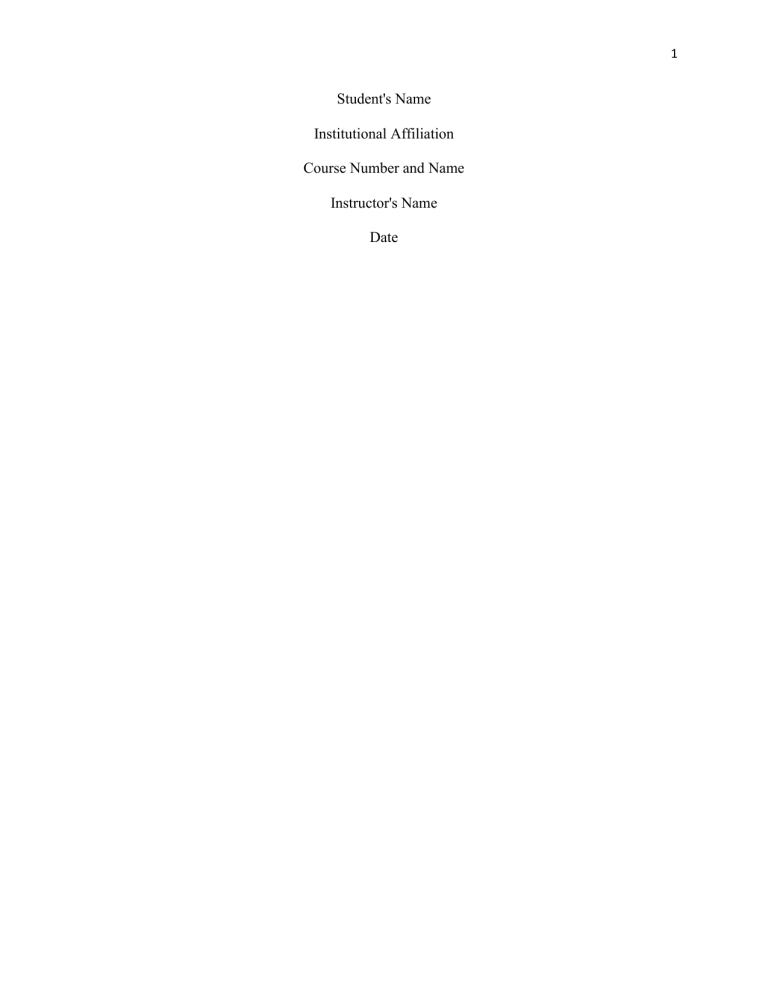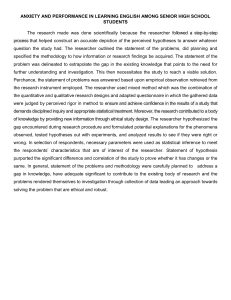
1 Student's Name Institutional Affiliation Course Number and Name Instructor's Name Date 2 Introduction The firm has realized that many people in minority groups, including African Americans, Hispanic Americans, Asian Americans, and Native Americans, and those whose education level is high school, do not invest. Therefore, this study aims to find exploratory research that can be done to develop business with these minority markets. The study also seeks to find factors that should be considered in designing a focus group with the clients, more so those with high school education levels. Research Objectives The objectives of this case are to identify appropriate exploratory research strategies for the situations described and to consider factors in developing effective research methods, e.g., questionnaires and focus groups. Research Statement Many people in minority groups per race and low education level do not invest. This research seeks to find the exploratory study that should be conducted to help these people invest. Ethical Considerations in Research Due to companies' growing use of marketing research studies, there has been an increased focus on ethics. Ethical considerations in research are principles that guide research designs and practices(Bhandari, 2022). The considerations are meant to protect the rights of research participants, enhance research validity, and maintain scientific integrity. If ethical issues are not considered in research, the research find loses value because the results will be morally questionable, and no company will trust the data collected. 3 The scholarly marketing community has always shown concern for ethical issues during marketing research. It has therefore established a code that delimits responsibilities to respondents and prospective respondents, clients and vendors, profession, and legal features(Esteban-Bravo & Vidal-Sanz, 2021). In addition, the international commerce chamber and ESOMAR have a code that must be observed during marketing research. The code deliberates the basic fundamental principles of research. The principals state that; i) the researcher conforms to all relevant national and international laws ii) researcher behaves ethically to protect the reputation of market research iii) the researcher takes care when carrying out research among young children. iv) The researcher gives the respondents the freedom to cooperate voluntarily by providing adequate information that is not misleading. The following general principles shall apply under research ethics based on the above code because the intended respondents are from a minority group. The general principles include voluntary participation, informed consent, anonymity, confidentiality, and potential harm. Voluntary participation dictates that the participants be given the freedom to choose to participate in the research. The researcher is responsible for providing adequate information about the study's intended purpose and the nature of the project (Esteban-Bravo & Vidal-Sanz, 2021). In addition, the participants are free to opt out of the study if they so wish at any given time. 4 The researcher is responsible for ensuring the participants give informed consent before the investigation begins. According to Bhandari(2022), informed consent entails Letting Participants know the purpose, benefits, risks, and funding behind the study before they agree or decline to join. For instance, the group with only a high school level of education must understand the study's purpose before I begin the investigation. Anonymity and confidentiality are other ethical issues to be considered. The responses must be kept anonymous by omitting the respondents' personal identification data. Also, confidentiality entails keeping the data private and ensuring that it cannot be linked to any other data in case of a similar study. Another ethical issue to consider is potential harm. It is the responsibility of the researcher to protect participants from any physical, psychological, and social damage. Any harm should be eliminated or kept at a minimum( Bhandari, 2022). The above study is to be carried out among a minority and vulnerable group. Therefore, the study questions have to be designed in such a way as to ensure they are friendly to the participants so that they don't cause any psychological or social harm. Qualitative Research Marketers and other social researchers use qualitative research to obtain weakly structured information from a social system. Qualitative research allows the researchers to interpret data and develop a tentative theory about the method the data describes. Through a qualitative study, the researcher can define the critical constituents of the problem and how they are interrelated. Further, the information can diagnose a situation, select alternatives, and 5 discover new ideas. The above study shall employ qualitative methods such as in-depth interviews, focus groups, and observation. In-depth Interviews An in-depth interview is a type of conversation or personal interview conducted for research purposes. A single respondent is directly questioned by an interviewer using open questions. The interviewer focuses on a specific topic (Esteban-Bravo & Vidal-Sanz, 2021). The goal of in-depth interviews is to uncover a wide range of specific and detailed information about a topic. In-depth interviews are semi-structured and thus require some amount of planning. A standard paradigm that is used entails using the 5Ws. The interviewer asks the WHO, WHAT, WHERE, WHEN, and WHY questions. However, care should be taken with the WHY question because it can be misleading. Most times, participants tend to give justification when asked WHY. In-depth interviews can be successful by applying the cooperate principle(Grice's maxims of conversation). The maxims are summarized into quality, quantity, relation, and manner. i) Maxim of quality- make a genuine contribution and do not say something without evidence. ii) Maxim of quantity-make a conversation that is informative enough. Not too much or too little. iii) Maxim of relation- be relevant. However, relevance can switch a little in the course of the conversation. 6 iv) Maxim of manner- be brief and orderly, and avoid obscurity and ambiguity of expression. In-depth interviews have their advantages. First, they provide in-depth insights because of their detailed responses. Second, they are free from social pressure due to one-on-one conversations. Third, it is the best way of dealing with a complex issue that cannot be discussed openly. In-depth interviews have their disadvantages. First, they are costly in terms of money and time. Second, the respondents' views do not reflect the general population's opinions. Third, the interviewer can easily be biased during questioning. Focus Groups The focus group is a data collection method in which the facilitator speaks with 6–12 participants about issues related to the research question. As an approach, the focus group offers qualitative researchers an efficient method of gathering the views of many participants at one time(Barret & Twycross, 2018). Also, the fact that many people are discussing the same issue together results in an enhanced level of debate, as the moderator steps back to let the focus group enter into a free-flowing discussion. Focus group is advantageous because it provides an opportunity to gather rich data from a specific population about a particular area of interest. Focus groups are arranged as per the types of participants. The participants are homogenously grouped into sociodemographic variables or behavior(Esteban-Bravo & VidalSanz, 2021). Each group has between 6 and 12 members. However, in some instances, the number of members can be reduced to 2 or 4. The number of focus groups depends on the issue's complexity to be discussed, and the group meeting can take between 1 to three hours. 7 In this study, homogeneity will be critical. Those with high school education levels will be grouped, and the others too, depending on race and their level of education. It is not being racist but ensuring that they are comfortable in the setting to participate freely. Observation Observation is a method of inquiry used in both natural and social sciences. When used in social sciences, the methods tell us what individuals are doing, but it does not explain why they are doing it(Esteban-Bravo & Vidal-Sanz, 2021). Observation can be direct, indirect, or biometry. In direct observation, the participants may or may not be aware that they are observed, and there can be a manipulative interaction with the observer. Indirect observation entails the observer tracing the activities performed by the subjects. Lastly, biometry is a physiological response of the participants observed to determine how they react to certain stimuli when exposed. Observation as a method is advantageous because the researcher collects first-hand information. Another advantage is that the researcher gets to experience methodological and ethical challenges(Taherdoost, 2019). However, the most disadvantageous point about observation is that the subjects may pretend to revert to their normal self later if they know they are being observed. Scaling One of the vital research tools is a questionnaire. Researchers conduct surveys and questionnaires to uncover answers to specific, important questions. Questionnaires and surveys can be practical tools for data collection required for research and evaluation. To develop a survey/questionnaire, first, the researcher should decide how to collect the necessary 8 data(Taherdoost, 2019). In this regard, scaling is the branch of measurement that involves the construction of an instrument. One of the most widely used scaling methods is attitude scales to measure instruments. The Likert scale is applied as one of the most fundamental and frequently used psychometric tools in sociology, psychology, information system, politics, economy, and other research. The best Likert scale to use is one with seven to eleven points. Research has shown that a seven-point Likert scale is the best in terms of reliability, validity, response style, respondent preference, and friendliness of the survey (Taherdoost, 2019). In addition, reliability is maximized using the 7-point scale, and validity is increased by increasing the number of points on the scale. Another study on respondent preference showed that participants preferred a scale with ten points, seven points, and nine points. Such scales were termed as easy to use. In this research, a seven point-scale will be the most preferable. According to Taherdoost(2019), the human mind has a span of absolute judgment that can distinguish about seven distinct categories, a span of immediate memory for about seven items, and a span of attention that can encompass about six objects at a time. Therefore, increasing response categories beyond six or seven might be futile. The following is a sample of the Likert scale to be used. The arrangement can either be ascending or descending. options 7-points 1 Strongly disagree 2 disagree 3 Slightly disagree 4 Neither disagree nor agree 5 Slightly agree 6 agree 7 Strongly agree 9 Conclusion After observing the ethical considerations, designing the questionnaire with a scale that respondents prefer, interviews, and focus groups should contain open-ended questions. The advantage of open questions is that it gives respondents room to express themselves. In addition, focus groups should be formed by observing homogeneity and a relaxed environment. Finally, reasons, why the minority group does not invest should be established, and further research should be done to determine how they could be assisted to invest. 10 References Barrett, David; Twycross, Alison (2018). Data collection in qualitative research. Evidence Based Nursing, (), ebnurs-2018-102939–. doi:10.1136/eb-2018-102939 Bhandari, P. (2022, May 7). Ethical considerations in research | Types & examples. Scribbr. https://www.scribbr.com/methodology/research-ethics/ Esteban-Bravo, M., & Vidal-Sanz, J. M. (2021). Marketing research methods: quantitative and qualitative approaches. Cambridge University Press. Taherdoost, H. (2019). What is the best response scale for survey and questionnaire design; review of different lengths of rating scale/attitude scale/Likert scale. Hamed Taherdoost, 1-10.

